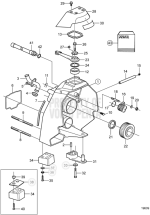kd4pbs
Petty Officer 1st Class
- Joined
- Mar 5, 2012
- Messages
- 319
Could some of you smart people help me out here?
Something dawned on me while reassembling this DP-SM I've been working on all summer in my spare time... Of course, it's not so much particular to VP, but I guess could apply to Mercruiser's and Yamaha's I/Os as well. I've done the same thing on 3 other Mercruiser drives before, but never really thought about this...
The transom shield has the cylinder / sleeve cast into it which extends through the inner plate into the inside of the vessel. The bellows is of course attached to the rear (outer) lip of this sleeve, and is sealed against the input to the drive's upper unit. This of course creates a (usually) waterproof seal between the input to the drive and the transom shield.
Inside of this sleeve lives our gimbal bearing, further forward, on the inboard side. In front of this, sealed against the sleeve lives a seal (part # 21) which seals the space between the sleeve and driveshaft. As long as the seal is working, there is no way for any liquid to pass from behind it to in front of it. I'm pretty sure I remember the two Alpha's and the one Bravo I have totally R&Rd had this seal as well, but I might be mistaken.
All of us who have an I/O have been told that a cracked bellows will sink our boat. I don't understand how it would, unless the seal which seals the driveshaft to the sleeve fails. Yes, the bearing would get saturated, as well as the nose of the drive's input shaft/yoke, and the u-joints... everything aft of this shaft seal, but I don't see where water could get into the boat with a good seal. Perhaps older drives didn't have this seal and the fact that they could sink with a compromised bellows just got carried on to the drives with driveshaft seals without considering that important change?
I'm sure my thick skull is missing something here, so what is it?

Something dawned on me while reassembling this DP-SM I've been working on all summer in my spare time... Of course, it's not so much particular to VP, but I guess could apply to Mercruiser's and Yamaha's I/Os as well. I've done the same thing on 3 other Mercruiser drives before, but never really thought about this...
The transom shield has the cylinder / sleeve cast into it which extends through the inner plate into the inside of the vessel. The bellows is of course attached to the rear (outer) lip of this sleeve, and is sealed against the input to the drive's upper unit. This of course creates a (usually) waterproof seal between the input to the drive and the transom shield.
Inside of this sleeve lives our gimbal bearing, further forward, on the inboard side. In front of this, sealed against the sleeve lives a seal (part # 21) which seals the space between the sleeve and driveshaft. As long as the seal is working, there is no way for any liquid to pass from behind it to in front of it. I'm pretty sure I remember the two Alpha's and the one Bravo I have totally R&Rd had this seal as well, but I might be mistaken.
All of us who have an I/O have been told that a cracked bellows will sink our boat. I don't understand how it would, unless the seal which seals the driveshaft to the sleeve fails. Yes, the bearing would get saturated, as well as the nose of the drive's input shaft/yoke, and the u-joints... everything aft of this shaft seal, but I don't see where water could get into the boat with a good seal. Perhaps older drives didn't have this seal and the fact that they could sink with a compromised bellows just got carried on to the drives with driveshaft seals without considering that important change?
I'm sure my thick skull is missing something here, so what is it?




















